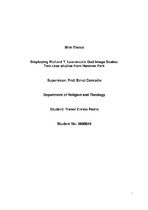| dc.description.abstract | This study is situated in the field of Practical Theology with specific reference to empirical studies on the God-images that lay people operate with in their daily lives. It is often observed in the discourse on theology and development that the images people hold of God reflect a sense of power or powerlessness but may also influence the way lay people respond to their social environment. This applies irrespective of religious or denominational affiliation, age group, gender, occupation or socio-economic standing. In particular, this study focusses on two congregations, namely St Dominic’s Anglican Church and the Pentecostal Protestant Church, both located in Hanover Park. These are selected because they represent diverging theological traditions that may or may not shape people’s God-images. The assumption is that whether people see God as law-giver and law-enforcer, a strict judge, an advisor, an advocate, a close friend, a problem-solver or dispenser of goods and services, that this would make a significant difference to how people view themselves in relation to their world. Whilst this interest in understanding the types of God-images and the influence these God-images might have on particular groupings of people is not new, the interest in God-images is new within the field of practical theology (Counted 2015; Hoffman 2005; Lawrence 1997). The God Image Scale that was developed by Richard T. Lawrence (1997), is used in this study. Lawrence (1997:214) a Roman Catholic priest, who served as a pastor at St. Vincent de Paul Church in Baltimore Maryland, developed two instruments namely the God-Image Inventory (GII) and the God Image Scales (GIS). Whilst the GII is used within clinical and pastoral counselling, the GIS has been more widely used in empirical studies in the field of religious psychology and, especially in North America, on the ways in which images of God function amongst specific groups of people. These instruments have not been widely used in the African or the South African contexts although Africa is widely regarded as “notoriously religious”. Such findings on God-images may be significant for Christian education in violence-ridden communities, not only in Hanover Park. The significance of this study on God-images within a specific community context is tied to the complexities of attempting to measure the quality of an individual’s God- image across different denominations, religious beliefs, religious practices and religious educational frameworks. Of equal importance is the need to distinguish between the influence that different doctrinal teachings and religious practices have on the formation of God-images and God-concepts. Whilst people who are social beings learn from their contexts, are influenced by their experiences and make choices based on intrinsic and extrinsic motivational factors, the corpus of God-image literature recognises the pivotal role and influence that one’s God-image have on religious knowledge, attitudes and behaviours within any given context. | en_US |

